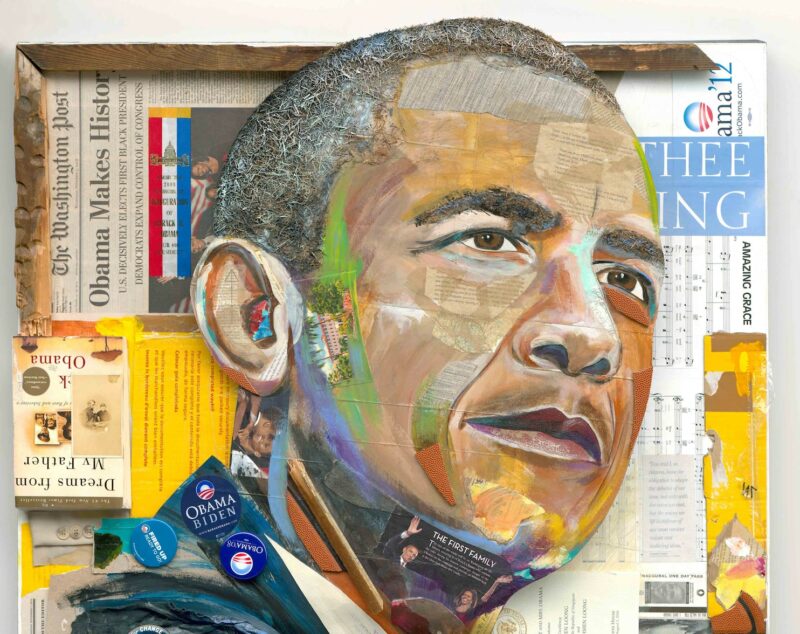Reflections on Obama’s Narration of America in the Middle East: No “Promised Land” for Arabs
Narratives matter in politics, and the narratives of the powerful tend to reinforce their international supremacy. Barack Obama’s latest contribution to the American presidential memoir genre will likely carry significance beyond a truthhood-falsity barometer we have grown accustomed to use with the epithets, statements, and Tweets of the sitting President Donald Trump that can tend to lean towards ‘fake news.’ Certainly, the commercial value of the 700-odd page tome, reportedly worth tens of millions of dollars combined with his wife Michelle Obama’s own memoir, Becoming, released last year, is striking.
(Like–and unlike–the Clintons before them, the Obamas have become a brand.) Beyond the capitalist beneficence, however, any staying power of A Promised Land, including whatever controversy it generates, rests on the story spun by the 44th president. What does he narrate about his political career, about the world of America and America in the world—especially the Middle East?
(Re)Constructing America’s ‘Middle East’
The policies of US presidents, especially those who serve two terms like Barack Obama and George W. Bush before him, become part of the ‘structure’ of asymmetrical power relations, revitalized (or not) dealings with dictators, and positions vis-a-vis Arab peoples. Indeed, the retelling itself becomes part of the policy, as power and knowledge intertwine repeatedly. Such narratives serve in justifying, explaining, and defending US uses and misuses of economic, military, and diplomatic power.
The international hegemon, a complicated and complex web of actors, institutions, and viewpoints held together by some variant of what Obama calls the ‘American idea,’ tells itself to the world, in part through its former presidents.
Here is one reason why Arab and Middle Eastern audiences will be especially attuned to Barack Obama’s official perspective on the motivations and wrangling of his presidency.
That the Arab Spring unfolded under his watch only piques readers’ curiosity. And while President-elect Joe Biden, Obama’s Vice President, has insisted that his presidency will not be a “third Obama term,”3 the 44th president’s narrative can offer clues about where Biden stood and the paths he might chart today. Generally, Obama seems to place him in the “Washington playbook”4 school, a veteran Washingtonian with vast experience heading the Senate Foreign Relations committee.
When it comes to the Middle East, Obama offers a number of well-worn profiles (sharia’hobsessed Islamists,5 brain-washable, violent youth6 ) and familiar narrations (sectarian angst,7 cauldrons of instability) as he chronicles his time in office up to the spring of 2012, near the end of his first term.
The book’s content is suggestive, and so is its form. That this wordsmith ends the first volume of his presidential memoirs (Part II will follow) with the killing of Osama bin Laden is telling. In the closing chapter 27, Obama dramatically recounts the intelligencemilitary-diplomatic synergy, for him a tense and emotional sequence culminating in the “neutralizing” of a target (with the codename “Geronimo”)8 for whose ten-year manhunt the most powerful country in the world mustered its best and bravest.
Replete with a precarious helicopter landing, as Bin Laden was “brought to justice” amid “audible gasps” by the National Security team onlookers and an understated “We got him” by the Commander in Chief,9 the cinematic ending recalls the Hollywood version Zero Dark Thirty–exactly how much more factually exactly,10 perhaps no reader will ever know. Here Obama ties the knotty thread running through the entire narrative, of missions, successes, and failures marked by the performance of the mightiest military machine on earth: the US armed forces.
The President who had campaigned on a platform decrying George W. Bush’s “dumb war” in Iraq does not seem to glorify the US armed forces, with their technologicalorganizational-logistical acumen and synergy “that the US military does better than any organization on Earth”11 any less than his predecessor.
Neither does he appear disinclined to US militarism, in foreign policy (as in, “the prudent use of American power”12), or in domestic ‘brownie points’ variants of paying tribute to soldiers (such as visiting injured veterans at Walter Reed Hospital) and offering “support” to their families (including one of his wife’s major initiatives as First Lady, “Joining Forces”13). Surprised at his Nobel Prize, he decides it is a “call to action.”14 This energy easily strikes on as mobilization in service of what reads as an unapologetic US supremacy, military first, human rights and democracy second.
Obama was perennially plagued by “nativist” suspicions (birtherism,15 a pet narrative of Donald Trump doubting Obama’s Hawaiian delivery), accusations that he might be less than patriotic (the Reverend Wright debacle of the 2008 campaign, during which he duly distanced himself from his former pastor16) or ‘soft’ on terrorism (the botched attempt to shut down Guantanamo17).
It is as though this first black president seeks to set the record very, very straight. I am no less violent than the roster of white, establishment commanders in chief that came before me. I see the Middle East as no less of a “troubled place,” to paraphrase Edward Said, than did they.
In fact, Obama uses a number of such stereotyping phrases to describe the region: “scary but manageable” before 9/11;18 “dysfunction of the Middle East”19; wondering about “another Middle East war”20; invoking “problems in the Middle East”21; and musing on the eve of the 2011 uprisings “where the next major Middle East crisis would most likely occur.”22 He hardly fails, that is, to live up to Orientalist and Orientalizing expectations.
Idealism vs. Realism
Obama attempts to frame himself as defender of what he calls the “American idea”: “what the country was, and what it could become,” combined with “the notion that America was the greatest country on earth.”23 This American exceptionalism—a tempered form, perhaps, of 19th century “manifest destiny” infused with historically genocidal ideologies and practices—persists in an almost unbroken form among US presidents.
For Obama, the American idea or “idea of America” is apparently propelled by “individual determination” that yields collective aspirations and successes spanning some mix of democracy, freedom, equal opportunity. Yet, recurring theme of the book is how Obama tangles with the actualities, strains, and tradeoffs of US leadership, such that the presidency modulates his idealism, injecting him and his policies with a healthy dose of “realism.”
That his two terms are often characterized as manifestations of the failure of the US foreign policy leadership in a Middle East may not cross the mind of readers meeting him for the first time in these pages. Perhaps that is why he spends most of the enormous volume recounting in painstaking detail his domestic battles. The American Recovery and Reinvestment Act, bailouts that he claims saved the US economy, Keynesian style, after he inherited a recession.
The relatively progressive Affordable Care Act in healthcare, dubbed “Obamacare” by naysayers, the “DREAM Act” to formalize the status of undocumented immigrants, a bill that did not make it past the Senate. Democrats vied endlessly with Republicans to transform “Yes We Can” from a campaign slogan to some modicum of material improvement in the lives of Americans.
The subtext, of course, is a self-styled contrast with his successor, Donald Trump, and the “genuine populist surge within the Republican party”24 and its base, foreshadowed by the rise of the Tea Party and the underqualified, Sarah Palin, 2008 presidential candidate John McCain’s vice-presidential nominee, later a Fox News commentator.
His administration saw many “firsts” and novelties: the US’s first African American president with a Muslim father to boot, a flock of young Washington outsiders running the White House, not to mention protests and revolutions calling for democratic change in the Arab world —Yet Obama’s narrative confirms the cliché that the more things change, the more they stay the same.
Unabashed Militarism
Somewhat paradoxically, the Nobel Laureate Obama did not steer US foreign policy toward a peaceful course. Indeed, one clear theme in the book is the justification and defense of US militarism, especially vis-a-vis the Middle East-so long as the ‘right’ wars are waged, and the “prudent” operations conducted. We see in fact a valorization of the US military, thus contributing to the hyper-militarism of US foreign policy, reinforced by and reinforcing what some argue routinizes militarism even “at home.”
For the Middle East, —such an engrained war-making culture seems to amount to a view that soldiers and security personnel can for the most part do no wrong. (Trump’s recent pardon of the Blackwater perpetrators of a 2007 massacre in Iraq26 is a well-publicized example of institutionalizing military impunity, albeit to much uproar.)
Even, if warmongering commanders in chief get their geography mixed up (Iraq instead of Afghanistan, according to Obama), soldiers remain a symbol of unbounded ‘service,’ giving, sacrifice, in the name of American ideals. Even opposing Bush’s war in Iraq, writes Obama, “I’d always been careful to distinguish between my views on the war and the appreciation for the sacrifices of our troops and their families.”
In fact, Obama was quite gung-ho about killing in his so-called ‘war against al-Qaeda.’ Relabelling Bush’s “War on Terror” did little except improve appearances. He claims that he was so insistent on capturing (killing!) Bin Laden so that he could puncture the illusion of superhuman terrorists: so that Americans and those around the world could see “that these terrorists were nothing more than a band of deluded, vicious killers—criminals who could be captured, tried, imprisoned, or killed.”
This attempt at defanging the terrorist bogeyman in the public imagination, so to speak, did little if nothing to de-militarize American foreign policy, or tone down what critics see as its neo-imperialist military interventions. Obama in fact hid behind the guise of legality to personally authorize American killings of suspected terrorists, venturing on a slippery slope shrouded in secrecy with little oversight.
He personally oversaw a “kill list,” where he ordered the trigger pulled (or drone deployed), as a New York times investigation revealed. This authorization came after a “nomination” process where his military and counterterrorism advisers suggested who should be killed next.
The President, then, did not waver from what had become the US’s interminable, understated counterterrorism rampage (for instance, undercounting civilian casualties) in the US and in the Middle East. In fact, the former University of Chicago Law School professor-turned-president quietly, through extensive legal acrobatics, “had preserved three major policies–rendition, military commissions and indefinite detention” that since the Bush years had fomented scathing criticism on human rights grounds.29 This included, of course, killing US citizens “Al-Qaeda cleric” Anwar Al-Awlaki and Samir Khan in September 2011.
Readers get no apology for Obama’s notorious drone warfare. Commencing only 3 days after his inauguration, Obama ordered a total of 542 drone strikes during his tenure in the White House, killing “an estimated 3797 people” in what became a hallmark tactic of his presidency.
He did his fair share, that is, in the accumulation of “direct deaths” estimated in November 2018 as somewhere between 480,00-507,000 in the US-led wars in Afghanistan, Iraq, and Pakistan after 9/11 (a number that excludes, for instance, casualties in Syria)31-all likely conservative estimates. And how does he narrate this personalized killing spree that spanned his presidency? Young men like the three Somali pirates killed by US forces upon hijacking Captain Richard Phillips aboard his ship in 2009 apparently inspired mixed feelings for Obama.
He knew that across the Muslim world, he writes, “millions” of such men had been “warped and stunted by desperation, ignorance, dreams of religious glory” that propelled them to violence. American messianism rears its head: “I wanted somehow to save them” through education or employment, he confesses.
Realities get in the way of their salvation, however: “the world they were a part of, and the machinery I commanded, more often had me killing them instead.”32 His ambivalence belies a convoluted mix of an almost (neo)colonial savior complex whose flip side is unbridled violence against the Other. “Their world” is to blame, as is the unfortunate (for them!) reality that he is at the helm of a “machinery” that could not be on the same side as unruly Somali, Iraqi, or Afghan youth.
Through such binarism, Obama seems to delink the Arab or Muslim Other’s pathologies from America’s imbrication in the manifold problems of poverty, marginalization, despotism that plague the Middle East. So, we are left astounded: it is their fault that he must kill them?
That US militarism remains an untouchable bastion of its foreign policy, underpinning its nationalism (where is it ‘civic’ when the military takes center-stage?) is no surprise. Yet Obama’s confirmation and unblinking justifications of US militarism—rendered more direct, more personal, more efficient under his watch, perhaps–should not escape Middle East readers and observers.
Arab (and all) readers may rightly view Biden’s election as a refreshing departure from Trump’s less suave, chauvinist style and policies, but they should perhaps disabuse themselves of the notion that Obama’s former Vice President is likely to de-militarize US foreign policy.
Yet the ‘kill list’, the expanded drone attacks, and even the story of finally ‘getting’ Osama bin Laden where Obama situates himself as reining in the War on Terror, is unconvincing. The US is actually an important part, instigator perhaps, of much of Middle East violence. Not just via its military-industrial complex, but also via cultural tropes that Obama too, and not just Bush who initially proclaimed the War on Terror a ‘Crusade’, perpetuates.
Who can forget when President Obama, in his 2016 State of the Union speech, described the “transformation” in the Middle East as “rooted in conflicts that date back millennia”33? Obama in fact ended up re-expanding the War on Terror with the Global Coalition to Defeat ISIS, launched in 2014. True, this time the coalition included many Arab participants.
The point here, though, is that since the Cold War, raging violent conflicts within the Middle East is not without clear and traceable US fingerprints. From the Israeli-Palestinian conflict, to the series of Gulf wars and Iraq, to the successive iterations of the War on Terror, the US has a finger—pulling triggers, bankrolling the guns, dropping bombs, building bases, stationing troops, launching drones—in every violent conflict in the region.
It was disingenuous in 2016, just as it is disingenuous now, to cast the Middle East as a perennially violent region, outside the remit and the reach of the United States of America.

 Larbi Sadiki
Larbi Sadiki

